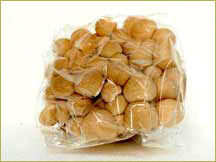Beech Mushrooms

(shimieji, hon-shimieji, buna-shimeji, clamshell, alba clamshell, pioppini, chiodini ) Hypsizygus tessulatus
Yes, they do look like they come from outer space. Each cluster resembles a little mob of mocha-headed mushrooms bursting out of a trap door. These sweet smelling little mushrooms are now grown in the U.S. thanks to the pioneering work of Japanese growers, and are available the year round. The flavor is cashew-like with an impression of sweetness. In keeping with the nut-like flavor, the texture has an unusual “crunch”. Even after cooking the mushroom has a nice crisp firmness.
The two countries who love this mushroom most, Japan and Italy, are two of the most mushroom passionate countries on earth. To everyone’s confusion, both countries use a bewildering assortment of names for this mushroom. In Japan the name shimeji applies to at least eighteen species. Hon-shimeji, buna-shimeji, an tomo-motashi are all used. The “true” hon-shimeji, Lyophyllum shimeji, is a cousin of Lyophyllum decastes, sold by Oregonians as the “fried chicken” mushroom. Meantime, shimeji is the name used by Japan-born chefs like Terra’s Hiro Sone when ordering. In Italy names like chiodini (little nails) or pioppini (cluster of trees) are used in addition to the tangle of Japanese names. Is this clear? I thought not.
|
Cleaning Cultivated Beech Mushrooms This should be unnecessary, particularly if they are in micro-pored bags.The cap should be bell-shaped with the margin (cap edge) rolled inward. This is a sign of a young mushroom picked when its texture is at its best. The stems should be crisp and white. The traditional cap color is brown, but a rarer white form is also grown. The Japanese and a couple of American growers package these in what looks like cellophane or plastic bags. These silly looking bundles are actually splendid. These small-pored bags delay the growth of a white downy substance on beech mushrooms. This white fuzz is actually the returning growth of the mycelium which originally produced the mushroom fruiting body. Though unsightly, this growth is harmless and can be melted away with a misting of water. If the mushroom texture is no longer crisp and you also see this downy growth, you are in possession of aging beech mushrooms. Harvesting Cultivated Beech Mushrooms They are most always cultivated, but do exist in the wild in Japan, Canada, and parts of the northern U.S. The name beech refers to their appearance on beech trees as well as elms and cottonwoods. Like many oyster mushrooms, they have the inconvenient habit of growing high up on the trunk of a dead or dying tree. Looking upon these clusters you can recognize the strategy of growing in a multi-headed mass out of a crack in the wood. Multiple mushrooms on longer stems maximize their ability to send their spores aloft. Cooking Cultivated Beech Mushrooms Other than grilling which I’ve never heard of anyone doing yet, there is no limit to your options. Beech are of course, well-suited to many Asian dishes. In American kitchens they seem to have an strong affinity for fish dishes. In Italy there are numerous recipes urging their use as a topping for risotto. Their “crunch” adds a textural flourish. In preparation the mushroom and stem are cut off the cluster about 1/3-1/2 way down the stem. Though the entire stem is tender and useful, the cap and upper stem tend to brittleness and can break leaving the little cap and stem separated. Cutting off the lower stem zone helps prevent this. They can be cut simply with kitchen shears while holding the base of the cluster. The remaining short stem section can be tossed in the stock pot. Storage Cultivated Beech Mushrooms If purchased in clusters free of the protective bags, use them within 5 days. If purchased in the cellophane bags, leave them in those bags until ready to use. These bags, even though they look so wrong, will keep the mushrooms in excellent condition for more than a week. |
 |
